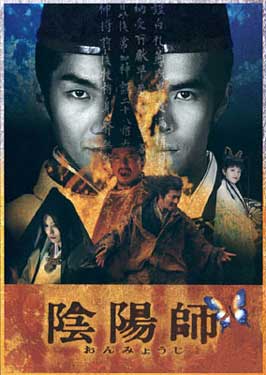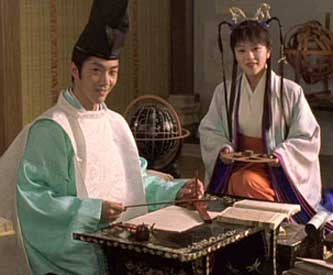 Cinematic heroic fantasy so rarely achieves the visual conviction of Peter Jackson's Lord of the Rings that one need only go a couple films down the list to conclude that fantasy films are almost always either cheap & ridiculous, or expensive & ridiculous. Cinematic heroic fantasy so rarely achieves the visual conviction of Peter Jackson's Lord of the Rings that one need only go a couple films down the list to conclude that fantasy films are almost always either cheap & ridiculous, or expensive & ridiculous.
Whatever sense of wonder invests itself in the written literature all too often comes off goofy on the big screen. & while one would think advances in CGI technology would make the creation of Other Worlds a cinch, it often seems that technologically simpler films such as Jason & the Argonauts (1963) with its startling swordfight sequence with skeletons, or The Golden Voyage of Sinbad (1974) with its swordfight with the multi-armed Goddess Kali, driven by the stop-motion FX of Ray Harryhausen, vastly more awesome than today's over-computerized fantasy films.
But this may be true mainly of English language heroic fantasy films. I began watching Yojiro Takita's Onmyoji (aka The Yin Yang Master) with a sense that, even if it weren't a good film, I was going to love the Heian period costuming. But I found myself entering a truly mysterious, aesthetic world of magic & horror, played seriously but not pompously. Some viewers may take exception to the melodramatic qualities of the story, but this is a big story of mythic sweep, & it needed big performances. And fans of pulp fiction & such heroic fantasies as written by Robert E. Howard or Michael Moorcock may delight to know that Onmyoji is in fact the Japanese equivalent of pulp fiction, based on the popular serial-novels of Baku Yumemakura.
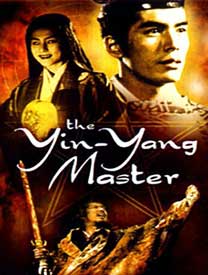 It's the kind of film that induces annoyed critics to give it one star, & Japanese film fans to give it the highest kudos. I suspect viewers who disliked it on DVD were watching the dubbed version; the dissonance & mediocre voice-acting ruins the film. It has to be seen subtitled so that the sound of the thing is as beautiful as the images on the screen. It may also just be unfathomable to viewers used to fantasy films being childish & simple, but readers of literary fantasy & science fiction will have much less trouble shifting into perspectives & premises that are genuinely unusual. It's the kind of film that induces annoyed critics to give it one star, & Japanese film fans to give it the highest kudos. I suspect viewers who disliked it on DVD were watching the dubbed version; the dissonance & mediocre voice-acting ruins the film. It has to be seen subtitled so that the sound of the thing is as beautiful as the images on the screen. It may also just be unfathomable to viewers used to fantasy films being childish & simple, but readers of literary fantasy & science fiction will have much less trouble shifting into perspectives & premises that are genuinely unusual.
Mansai Nomura is a well-known performer from the Kyogen theater of comic plays. He takes on the cinematic role of Seimei, who is an Onmyoji or Shinto exorcist in service of the aristicracy of Heian-kyo (Kyoto). Abe-no-Seimei was an historical figure, though the film is purely fantastic. Demons are abroad & a terrible vengeance-motivated hatred is infecting Kyoto, & it is up to Seimei to find the origin of this darkness & bring it into the light. There is an underlying philosophy that demons do not originate from outside the self, but are manifestations of human errors or choices.
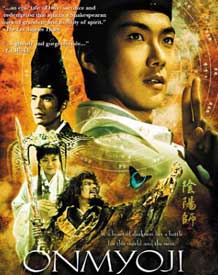 To some extent this is a film about good Shinto magic versus evil Esoteric Buddhist magic, though this prejudicial contrast may not have been intentional. The Buddhist villain Doson is played with grim & tragic ernestness by Hiroyuki Sanada, who Shinichi Chiba fans may remember as "Henry" Sanada in "Sonny" Chiba's heyday of filmmaking, when Sanada played heroic ninja youths & was Chiba's best-known protege. Sanada has matured into a serious character actor whose greatest of many fine performances was for Twilight Samurai (2002). As Doson he has such horrific appeal that the viewer almost wants him to turn out to be a hero rather than so relentlessly cruel. To some extent this is a film about good Shinto magic versus evil Esoteric Buddhist magic, though this prejudicial contrast may not have been intentional. The Buddhist villain Doson is played with grim & tragic ernestness by Hiroyuki Sanada, who Shinichi Chiba fans may remember as "Henry" Sanada in "Sonny" Chiba's heyday of filmmaking, when Sanada played heroic ninja youths & was Chiba's best-known protege. Sanada has matured into a serious character actor whose greatest of many fine performances was for Twilight Samurai (2002). As Doson he has such horrific appeal that the viewer almost wants him to turn out to be a hero rather than so relentlessly cruel.
I have seen hundreds of films set in the much later Tokugawa period, typically about masterless samurai. These do not provide a full readiness for Heian period films, which are comparatively rare, & are built around images right out of the Tale of Genji wherein the fold of one's robe has more significance than the position of one's sword. The idea of a heroic aesthete sorcerer among the aritistocracy was at first jarring to me, & I did for some while expect the crusty scowling Doson to turn out to be the hero, as he would be were he playing a severe ronin in a Kurosawa film, no matter how scary.
A Japanese viewer would have known Seimei at once as an historical spiritual leader for whom there are monuments & place names that keep his name alive in modern Japan. But I was not so aware of his history & so did wonder whether he was going to be the hero. Once I caught on that the aesthete almost faggotty Seimei really was the hero, the actor was great fun to watch as he used delicate movements & behaviors to express his character's inate goodness.
The colorfulness of events & characters captivated me. The maiden who was a blue butterfly; the paper dolls who become warriors; the grossly demon-possessed newborn infant; the Mikado's cast-off lover who becomes a demoness of grief & vengeance under Doson's sorcerous guidance; long-dead warriors rising zombie-like with superhuman fighting skills. Such things are easy to make look silly & most of today's heroic fantasy does make it all pretty silly. But Onmyoji, though hardly poker-faced, is serious about its story, as it should be.
Anyone who loves either the Tale of Genji or Japanese mythology will instantly relate to this film, but others may have to work at it a bit. A family film in Japan, its premises & assumptions are likely too alien for western children, so it becomes a defacto film for adult viewers.
The popularity of Onmyoji in Japan birthed a manga comic book series, a television series, & CD soundtracks. It also did wonders for the creaking instititution of the onmyoji which still exists. There was inevitably a sequel, released in the US on DVD in 2004, three years after the first film.
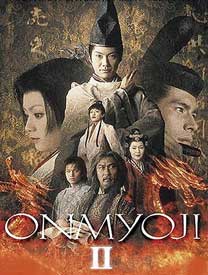 Onmyoji II retains all the key characters except the permanently defeated villain from the first part, & Sanada is a missed presence. The relationship between Seimei & the aristocrat Minamoto-no-Hiromasa (reprised by Hideake Ito) is further developed, though in both films he seems more observer than participant in Seimei's supernatural exploits. Onmyoji II retains all the key characters except the permanently defeated villain from the first part, & Sanada is a missed presence. The relationship between Seimei & the aristocrat Minamoto-no-Hiromasa (reprised by Hideake Ito) is further developed, though in both films he seems more observer than participant in Seimei's supernatural exploits.
The villain this time out is a survivor of a clan exterminated by the Fujiwaras who form the aristocracy of Heian-kyo. Viewers not aware of the classic Tales of the Taira may find some of the details impenetrable, but the film is easily understood in its broader strokes. By conjuration the villain manages to set in motion a long-in-simmering vengeance that involves the primary Shinto gods who are the first generation of the aristocracy. Here again, without knowing the mythological story of the Sun-goddess Amaterasu who withdrew into a dark cavern leaving the world in darkness, & of the savagery of her brother Susa-no-wo the god of rice & storms, developments in this film can seem even stranger than the strange things they are.
Some of the underlying story is unexplained because for the Japanese viewer it would be the equivalent of explaining Jesus in an English film. In essence the vengeful Mitsumushi (Eriko Imai) transforms his daughter Himiko the Tomboy Princess into an incarnation of Amaterasu, & his son Susa into the feral storm-god. If Susa will devour Himiko, Heian-kyo can be destroyed with one sweep of Susa-no-wo's ancient sword.
Much that is extreme & colorful happens, but it is not the equal of the first film, in part because the overlong climax is so silly visually. When Amaterasu/Himiko is devoured, Seimei to undo the destruction dresses up like the Goddess of Laughter & performs a dance that is supposed to incite Amaterasu to come back to the world from out of heaven, which is depicted as a giant golden egg. Cross-dressing Seimei dancing around the egg is more than a wee bit goofy & comes off as a particularly kitschy performance at a drag queen's ball. But you gotta give it big marks for not being the same-old same-old.
Both of the Onmyoji films are very winning on the basis of strangeness & originality. That there is definitely room remaining to make this two-film series a trilogy is hunkydory by me. These & similar films, such as the much more severe Gojoe: Spirit War Chronicle (2000), are perhaps a little harder to enter from a western point of view, building as they do on purely Japanese spiritual & mythic assumptions, & on tales well-known only within Japan.
There is no risk of these being "faulted" as "too much like John Ford" as was the cliche criticism of Kurosawa whose first flushes of fame were greater in the west than in his own country. The average film fan may never get past the essential "differentness" of such films, but presumedly readers of science fiction & fantasy fiction, as well as hardcore Asian film fans, will not have such a difficult time connecting with ideas & images & storylines that shift very far from the mundane.
copyright © by Paghat the Ratgirl
|
